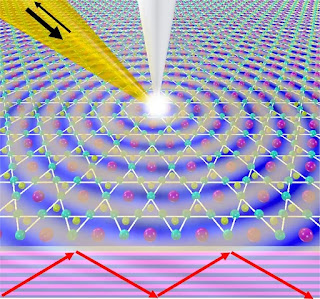'
"A diagram of the Kagome metal cesium vanadium antimonide showing plasmon waves moving through the material. Credit: Guangxin Ni" (ScitechDaily, Weaving Light: Unraveling the Quantum Lattice of Kagome Metals)
Graphene is not the only interesting 2D material in the world. The metal combinations called Kagome metals can also create the 2D metal structure. Kagome metals have a triangular 2D shape. That shape is like Kagome. The optical Kagome lattices are always interesting, but modern technology can make it possible to create Kagome nanostructures. The plasmons that travel through that structure make it possible to manipulate the nano-scale optical abilities of that material.
The Kagome metals can used to aim electric impulses to the target. The Kagome structure can collect electromagnetic waves from the air. And then aim it at one point. That thing requires that Kagome. Which collects radiation and has a triangular shape. This thing allows us to transmit information and energy into plasmon. And that manipulates plasma oscillation.
The system can collect energy from plasmon. That travels in it, into one point. And plasmons that travel in 2D Kagome metal structure, can manipulate light waves over the lattice. In this process, the laser beam that injects energy into the plasmon can form waves in the Kagome lattice. The thing is that those light waves can used to give new abilities for new quantum materials.
Wikipedia describes plasmons like this: "In physics, a plasmon is a quantum of plasma oscillation. Just as light (an optical oscillation) consists of photons, the plasma oscillation consists of plasmons. The plasmon can be considered as a quasiparticle since it arises from the quantization of plasma oscillations, just like phonons are quantizations of mechanical vibrations." (Wikipedia, Plasmon)
Above: Optical Kagome.
Thus, plasmons are collective (a discrete number) oscillations of the free electron gas density. For example, at optical frequencies, plasmons can couple with a photon to create another quasiparticle called a plasmon polariton. The field of study and manipulation of plasmons is called plasmonics." (Wikipedia, Plasmon)
"In physics, polaritons are quasiparticles resulting from strong coupling of electromagnetic waves with an electric or magnetic dipole-carrying excitation.[example needed] They are an expression of the common quantum phenomenon known as level repulsion, also known as the avoided crossing principle. Polaritons describe the crossing of the dispersion of light with any interacting resonance. " (Wikipedia, Polariton)
"To this extent, polaritons can also be thought of as the new normal modes of a given material or structure arising from the strong coupling of the bare modes, which are the photon and the dipolar oscillation. The polariton is a bosonic quasiparticle, and should not be confused with the polaron (a fermionic quasiparticle), which is an electron plus an attached phonon cloud." (Wikipedia, Polariton)
Researchers noticed the plasmons that travel through Kagome metal called Cesium-Vanadium-Antimonide (CsV3Sb5) cause light waves above that structure. That knowledge is interesting in nano-optics. The nano-optical phenomenon opens new routes in new optical systems. That makes new and smaller robots possible. However, the ability to control those light waves makes it possible to create structures. That is invisible to the human eye. The idea is that plasmons can manipulate the wavelength of the reflecting light.
https://scitechdaily.com/weaving-light-unraveling-the-quantum-lattice-of-kagome-metals/
https://en.wikipedia.org/wiki/Plasmon
https://en.wikipedia.org/wiki/Polariton





No comments:
Post a Comment
Note: Only a member of this blog may post a comment.